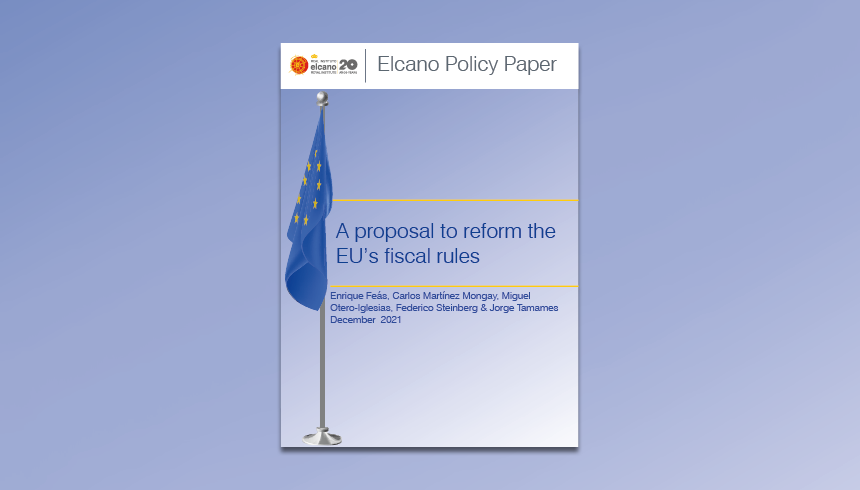Index
Executive summary – 5
Introduction 7 – 8
(1) The need for a permanent fiscal capacity 9 – 12
(2) Reforming the preventive arm 13 – 16
(3) Reforming the corrective arm 17 – 18
(4) Governance and ownership 19 – 20
Annexes 21 – 23
Executive summary
- The EU’s fiscal framework must be reformed. The current rules are asymmetric and pro-cyclically biased, and they lack transparency and political ownership in the member states.
- The fiscal impact of the COVID crisis makes the reform unavoidable. The current macroeconomic scenario, with debt levels exceeding 100% of GDP, adds up to the already existing problems and deficiencies of the Stability and Growth Pact.
- Not reforming is not an option. It would require the Commission to strictly apply the existing rules, which could derail economic recovery, or to ignore them altogether, undermining the authority and reputation of Europe’s institutions.
- The Commission should make a bold reform proposal and force a thorough debate at the Council in order to bring about substantial changes in the fiscal framework. We believe that there are politically acceptable reform options to improve the current framework, including the mechanisms and institutions created over the past decade, which would prevent fiscal profligacy, stimulate economic growth through reforms and ensure ownership of the process at the national level, while increasing risk sharing and control. The Commission’s proposal should be considered a top priority, avoiding unnecessary delays.
- The overarching element of the reform would be a permanent central fiscal capacity, consolidating and institutionalising the Next Generation EU instrument, transformed into a new pan-European investment mechanism. It would finance EU public goods (especially green and digital investments, with considerable external effects) and would also ease the path of adjustment of member states towards a solid and sustainable fiscal position, no longer defined by arbitrary reference values (such as the 60% debt rule), but as the result of a process of analysis and permanent interaction with EU institutions.
- The aim must be to return to balanced fiscal positions. Once this is achieved, the preventive arm would be based on a simple and observable primary expenditure rule (complemented with a safeguard for highly indebted countries) which would replace other indicators such as the structural balance or the expenditure benchmark.
- The reform of the preventive arm would be complemented with a strengthening of the accountability of national Stability and Convergence Programmes and Draft Budgetary Plans, as well as with an enhancement of member states’ fiscal policy assessments through a newly created European System of Independent Fiscal Institutions.
- On the corrective arm, we propose suppressing the 1/20th debt reduction rule and reforming the Excessive Deficit Procedure so that it can only be triggered by a simultaneous consideration of both debt and deficit indicators. Recommendations should concentrate on fiscal structural factors behind excessive deficits, and would not be required if the excessive deficit derives from asymmetric downturns.
- Finally, this debate should tackle other aspects of the Eurozone governance, including additional EU own resources and debt issuance. Democratic accountability must be reinforced by strengthening the European Parliament’s oversight over fiscal policy and taxation, reverting the intergovernmental tide. The European Stability Mechanism and other intergovernmental bodies must be fully included into the EU treaties, institutionalising and merging the figure of a Euro Finance Minister/Vice-president of the Commission, permanent President of the Eurogroup/Ecofin, and single representative of the Euro in international forums.
Introduction
The COVID-19 pandemic unleashed an unprecedented economic crisis. Member states and EU institutions reacted swiftly to guarantee an economic safety net for citizens under confinement. The European Commission activated the escape clause of the Stability and Growth Pact (SGP, henceforth the Pact), formally allowing member states to deviate from their path towards balanced fiscal positions by enabling automatic stabilisers to operate fully while undertaking discretionary expansionary measures. The European Council provided loans to member states for employment-support schemes in the form of an instrument for temporary Support to mitigate Unemployment Risks in an Emergency (SURE). The European Central Bank launched a Pandemic Emergency Purchase Programme that appeased the markets, and the Council and the Parliament approved the historic Next Generation EU (NGEU) recovery plan. The EU seems to have learnt from the mistakes made after the 2008 financial crisis, when austerity weakened social cohesion, inflicted needless economic damage and delivered lasting political volatility.
The current policy reaction to the COVID-19 outbreak, however, is not just an attempt to avoid previous mistakes. The macroeconomic scenario is radically different: if the 1990s were the years of the Great Moderation –characterised by low inflation, moderate interest rates, sustained economic growth and macroeconomic stability– the decade following the Great Recession stands out by deflationary risks, very low or even negative interest rates, and stagnant growth –so-called ‘secular stagnation’–.1 Whereas under the first scenario it was relatively easy to keep debt and deficit levels in line with the Maastricht criteria, a low-growth context makes it much more difficult to conduct budgetary policies under a one-size-fits-all fiscal framework.
Exceptional measures to fight the pandemic and mitigate its economic impact have made public deficit and debt levels soar. In the first quarter of 2021 the Euro area public debt exceeded 100% of GDP for the first time in its history (14 percentage points more than the previous year). This has stirred up the need for an overhaul of the EU’s fiscal architecture, understood both as the capacity for fiscal coordination at the European level and as a set of rules and guidelines.2 A return to the current Pact does not seem realistic. However, if no agreement is reached for the reform of the existing fiscal architecture, from 2023 onwards the EU will face a self-defeating dilemma: either re-impose austerity to comply with the existing rules and derail economic recovery, or ignore them altogether, thus undermining EU institutions, including the rule of law.
Resolving this impasse will dominate policy discussions between EU Finance Ministers throughout 2022. While we join an ongoing conversation, we seek to reinvigorate this debate, especially in Spain, and to participate in the public consultation recently launched by the European Commission.3 To this end, we propose a series of reforms of the EU’s fiscal rules, which include:
- Deploying a permanent EU fiscal capacity by consolidating and institutionalising NGEU (as a discretionary investment tool) to help member states reach a sound fiscal position that would be defined not by specific and arbitrary measures of deficit and debt, but by a permanent discussion with EU institutions.
- A preventive arm based on a clear and observable primary expenditure rule, which should be the objective and the permanent benchmark once the fiscal balanced position of a Member State has been reached. This rule could be complemented with a safeguard for highly indebted countries and would replace other indicators such as the structural balance or the expenditure benchmark.
- A reinforcement of the accountability of annual Draft Budgetary Plans and Stability and Convergence Programmes, enhancing the dialogue between national authorities and the Commission.
- The creation of a European System of Independent Fiscal Institutions, composed by the Commission, the European Stability Mechanism and independent fiscal institutions to help assess member states’ fiscal policies.
- A reform of the Excessive Deficit Procedure so it can only be triggered by simultaneous consideration of both debt and deficit indicators, suppressing the 1/20th debt reduction rule.
- Recommendations to correct excessive deficits by concentrating on fiscal structural factors –especially permanent components of the budget– but not required in the case of excessive deficits resulting from asymmetric downturns (as the common fiscal capacity should help member states to regain sound fiscal positions).
- A governance and ownership framework based on a simple idea: democratic fiscal oversight and control needs to occur at the level decisions are taken. At the national level, national parliaments need to make sure that the government adheres to the simple expenditure rule. At the European level, the European Parliament needs to control that the central fiscal capacity obtains the necessary own resources and that the central money covers the public investment gaps and fosters the needed reforms in member states.
1 On this subject, see B. Bernanke (2004), ‘The Great Moderation’, Remarks at the meeting of the Eastern Economic Association; R. Lukasz & L. Summers (2019), ‘On secular stagnation in the industrialised world’, Brooking Papers on Economic Activity, The Brookings Institution.
2 F. Steinberg (2021), ‘La nueva realidad de la política fiscal y sus implicaciones para España’, ARI, Real Instituto Elcano.
3 For previous proposals, see O. Blanchard et al. (2021), ‘Redesigning EU fiscal rules: from rules to standards’, Working Paper, nr 21/1, Peterson Institute for International Economics; M. Buti & M. Messori (2021), ‘The search for a congruent Euro area policy mix: vertical coordination matters’, VoxEU.org; P. De Grauwe (2021), ‘Euro Area fiscal policies and capacity in post-pandemic times’, European Parliament; European Fiscal Board (2021), ‘Annual Report’; O. Francová et al. (2021), “EU fiscal rules: reform considerations’, Discussion Paper Series, nr 1/7, European Stability Mechanism; Á. Ubide (2021), ‘An all-weather economic policy framework for the Euro area’, VoxEU.org.







